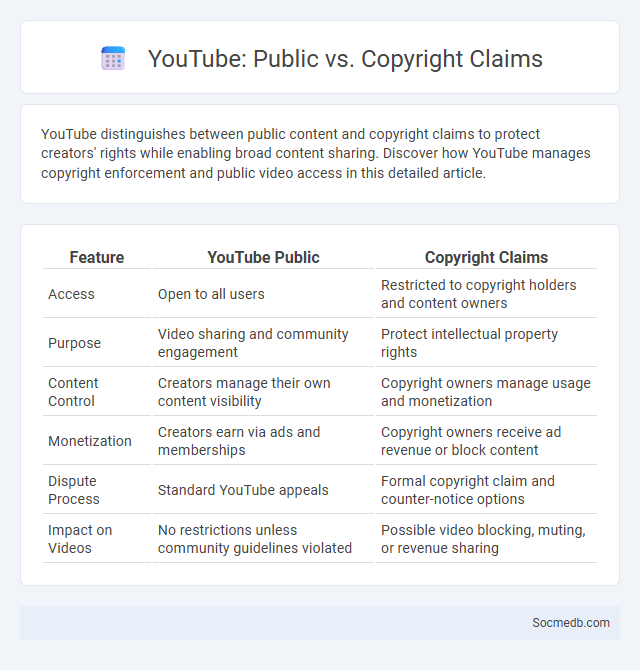
Photo illustration: YouTube Public vs Copyright Claims
YouTube distinguishes between public content and copyright claims to protect creators' rights while enabling broad content sharing. Discover how YouTube manages copyright enforcement and public video access in this detailed article.
Table of Comparison
| Feature | YouTube Public | Copyright Claims |
|---|---|---|
| Access | Open to all users | Restricted to copyright holders and content owners |
| Purpose | Video sharing and community engagement | Protect intellectual property rights |
| Content Control | Creators manage their own content visibility | Copyright owners manage usage and monetization |
| Monetization | Creators earn via ads and memberships | Copyright owners receive ad revenue or block content |
| Dispute Process | Standard YouTube appeals | Formal copyright claim and counter-notice options |
| Impact on Videos | No restrictions unless community guidelines violated | Possible video blocking, muting, or revenue sharing |
Understanding YouTube’s Video Statuses
YouTube video statuses include "Public," "Private," and "Unlisted," each determining the video's visibility and accessibility. "Public" videos are searchable and viewable by anyone, while "Private" videos can only be accessed by specific users invited by the uploader. "Unlisted" videos do not appear in search results or channel pages but can be viewed by anyone with the direct link, offering flexible sharing options for creators.
What Is a YouTube Public Video?
A YouTube public video is content uploaded to the platform that is accessible to anyone without restrictions or the need for a direct link. These videos appear in search results, recommendations, and channel pages, maximizing visibility and engagement. Public visibility on YouTube enables creators to reach a broader audience, enhance brand awareness, and drive traffic effectively.
Overview of Copyright Claims on YouTube
YouTube manages copyright claims through its Content ID system, which automatically detects and processes copyrighted material uploaded by users. Rights holders can monetize, block, or track content that matches their copyrighted works, helping to protect intellectual property while allowing creators to share material responsibly. This automated framework supports millions of copyright claims monthly, balancing the interests of rights holders and content creators on the platform.
Differences Between Public Videos and Copyrighted Content
Public videos on social media are accessible to all users without restrictions, often created for sharing and engagement, while copyrighted content remains the intellectual property of its creator or rights holder, with usage governed by copyright laws. Platforms implement content identification systems like Content ID on YouTube to detect and manage copyrighted material, preventing unauthorized distribution. Enforcement policies vary, including removal, demonetization, or revenue sharing, to protect creators' rights and maintain platform compliance with digital copyright regulations.
How Copyright Claims Affect Public Videos
Copyright claims on social media can result in your public videos being muted, blocked, or removed, limiting your content's reach and audience engagement. Platforms use automated detection systems that scan videos for copyrighted material, impacting monetization and visibility when violations occur. Understanding these rules helps you protect your content while respecting creators' rights to maintain your channel's integrity.
Steps Creators Can Take to Avoid Copyright Claims
Creators can avoid copyright claims by consistently using original content or securing licenses for all media elements, including images, music, and videos. You should leverage tools like YouTube's Content ID or Facebook Rights Manager to monitor and manage your content proactively. Implementing clear attribution practices and understanding fair use policies further help protect your social media presence from infringement issues.
The Impacts of Copyright Claims on Monetization
Copyright claims significantly affect social media monetization by restricting or demonetizing content that violates intellectual property rights. Your ability to generate revenue can be limited if platforms enforce copyright policies, leading to reduced ad revenue or content removal. Understanding and managing copyright claims is crucial to maintain consistent monetization and protect your social media earnings.
Resolving Copyright Claims on Public Videos
Resolving copyright claims on public videos requires understanding the platform's policies and the specific rights involved in your content. You should identify whether the claim is valid by reviewing the copyrighted material and, if necessary, submit a counter-notification or request permission from the rights owner. Protecting your videos on social media involves proactive content management and familiarity with digital copyright laws to ensure your content remains accessible.
Best Practices for Publishing Public Videos on YouTube
Publishing public videos on YouTube requires adherence to best practices such as optimizing video titles, descriptions, and tags with relevant keywords to enhance search visibility and audience reach. Engaging thumbnails, consistent branding, and regular upload schedules help build viewer loyalty and improve channel growth. Ensuring high video quality, including clear audio and HD resolution, along with adherence to YouTube's community guidelines, maximizes viewer retention and prevents content removal.
Summary: Navigating YouTube’s Public and Copyrighted Video Policies
YouTube enforces strict public and copyrighted video policies to protect creators' rights and ensure compliant content distribution. Your videos must comply with copyright laws, including fair use guidelines, or risk removal, strikes, or account suspension. Understanding YouTube's policy framework helps you navigate content sharing while avoiding legal and platform penalties.
 socmedb.com
socmedb.com